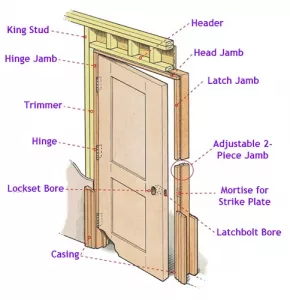Your Guide to Installing Pre-Hung Doors
A door not only adds to the beauty of the room but also increases efficiency. Why not replace your damaged slab door with a pre-hung door? But first, what is a pre-hung door? A pre-hung door is one where the slab door is already attached by hinges to a three-sided doorframe. It is also pre-drilled, mortised, and pre-cut to receive the hardware.
Pre-hung doors simplify the installation process to a great extent. However, you need to be sure of the measurements and several other things. We will be considering the following main topics:
- Pre-Hung Door Meaning
- Is it Hard to Install a Pre-Hung Door?
- What Do I Need to Install Pre-Hung Doors?
- How Do I Measure for a Pre-Hung Door?
- How to Remove a Pre-Hung Door from an Existing Door Frame
- Interior Pre-Hung Door Installation
- Exterior Pre-Hung Door Installation
- Pre-Hung Door vs Slab Door
- Conclusion
Pre-Hung Door Meaning
 A pre-hung door is a complete door package consisting of a slab door, own frame, and hinges. However, you may have to add some features later on. It is a ready-to-go, self-contained unit that can be installed in the doorway.
A pre-hung door is a complete door package consisting of a slab door, own frame, and hinges. However, you may have to add some features later on. It is a ready-to-go, self-contained unit that can be installed in the doorway.
Compared to regular doors, they are easy to install and simplifies the process. However, they require accuracy. And should be adjusted for the doors and jambs to fit right in the wall opening. If not, they may not hang well. In the case of exterior doors, they may not be as weather-tight.
Pre-hung doors come in a variety of sizes and materials such as wood, wood composite, metal, and fiberglass.
What Does a Pre-Hung Door Include?
A pre-hung door includes a door slab, three-sided door frame, and hinges. It is also a pre-cut hole for the doorknob, mortises, and strike plate. After installing, you need to paint/stain and fit the door with a knob.
Do Pre-Hung Doors Come with Trim?
Pre-hung doors can be of two types: one-piece jamb door that doesn’t have a trim. And a two-piece jamb door that has a trim (inside and outside) already applied to the frame.
How Long Does it Take to Install a Pre-Hung Door?
Installing a pre-hung door can take about 20 minutes to an hour at the max. However, it depends on factors including the expertise of the carpenter and correct framing. Interior doors do not take as long as the exterior since there is no weather-stripping. And this excludes the time taken to remove the existing door.
How Much Does it Cost to Install Pre-Hung Doors?
The cost to install a pre-hung door ranges between $400 – $1500. This is inclusive of both, material and labor. While this is a national average, the cost is also dependent upon the region and type of door.
Is it Hard to Install a Pre-Hung Door?
A pre-hung door is easy to install but it is still hard work for a novice not to mention the weight. You also need basic carpentry knowledge to get the job done to accurate standards.
Having said that, with a pre-hung door most of the work is completed for you. But you may have to take steps to ensure a proper fit especially the exterior door.
While installing a pre-hung door is pretty straightforward, it isn’t ideal for a DIYer or a novice. The door in itself is heavy and can leave you with a sore back. The frame, on the other hand, is flimsy prior to installing the unit. It is safer and cost-effective to have a general contractor or a carpenter fix it for you.
What Do I Need to Install Pre-Hung Doors?
 With pre-hung doors, most of the work is already done for you. You need the following tools to install the door:
With pre-hung doors, most of the work is already done for you. You need the following tools to install the door:
- 2-foot level
- 4-foot level
- Plumb bob (Plummet)
- Nail set
- Hammer
- Drill
- Screw gun
- Utility knife
- Screwdriver
- Small square
- Chisel – 3⁄4 inch
- 3-inch-long drywall screws
- Wood shims
- 8-penny finish nails
How Do I Measure for a Pre-Hung Door?
A pre-hung door comes with the frame already attached. While this makes installing easier, you need accurate measurements to purchase the right door.
Here’s how you measure the rough opening before buying a pre-hung door.
- Remove the trim from the rough door opening to get an accurate measurement.
- Make sure that the door studs stay level. If the studs are more than 1/4 out of plum, you need to level them out.
- Measure the door studs on the opposite ends of the doorway for the width.
- For the height, measure from the top of the rough opening to the floor surface.
- To measure depth, take the measurements from the front edge to the back edge of the opening.
If you are replacing the door, you need the measurements of the frame. Here’s how you take measurements of the door and frame. Ensure that you write the measurement to the minute detail.
- Use a painter’s pry bar to remove the casing from the door trim. Keep removing until you have pried out at the upper part and both sides.
- Measure from stud to stud to get the width.
- For the height, measure from the top of the frame to the floor closer to the right end. Move the tape to the floor surface on the left side of the door opening to the topmost part.
- Finish by measuring the jamb depth.
How to Remove a Pre-Hung Door from an Existing Door Frame
If you are looking to replace a pre-hung door, you need to remove the existing door from the frame. Here’s how you do that.
- Use a screwdriver and hammer to take out the hinge pins. Remove the door from the door frame.
- Remove the strike plate and the hinge plate.
- Use a stiff putty knife to loosen the trim.
- Remove the trim using a pry bar without damaging the wall. If the trim is in good condition, you can reuse it.
- Since the head and the inside jambs are nailed together, you can remove them at the same time.
- Pry the side jambs and then the head jamb. Remove the door frame with care.
Interior Pre-Hung Door Installation
Prepare the opening ready to install the interior door. The door frame should be somewhat smaller than the opening to allow for adjustments. Furthermore, pre-hung doors are heavy and quite challenging to maneuver alone. Ensure that you have a helper to help hang the door.
Here’s how you install a pre-hung interior door:
- Push in the pre-hung door through the rough opening. Add shims until the jamb is flat with the wall.
- Double-check if the door opens in the right direction.
- Check if the door is straight using a level. Slip shims to adjust the level;
- Use a level or plumb bob to check the wall surface and trimmer studs for plumb.
- Slip shims beneath the side jamb till the head jamb is level.
- Fill in the spaces between the side jambs and the stubs by adding shims.
- Shim between the hinges and the studs on the hinge side. Start with the top and bottom of the jamb. Position the shims so that half is above the hinge.
- Do the same on the latch side too. Check the door level again.
- Now nail the door frame through the shims and into the studs. Open and close the door; Make any adjustments as needed.
- Fix the trim to the jamb and studs using nails with a spacing of 16 inches.
- Install the trim on the other side in the same way. Trim the exposed shims.
- Finally, attach the doorknob, backplate, strike plate, and lockset.
Exterior Pre-Hung Door Installation
Keep in mind, that a pre-hung door comes as one single unit. Consequently, everything has to be installed at once within a day. Else, you’d have a large hole in your home which is not ideal.
Here’s how you replace an exterior door in your home.
- Remove the hinge screws from the jamb. Once the screws are out, take the door from the frame.
- Remove the fasteners (screws or nails) holding it in place. Take out the interior trim from the door.
- Install a z-flashing on the sill to prevent water damage.
- Apply a bead of caulk to both sides right where the exterior trim meets the walls. And another across the floor where the threshold of the door will sit.
- Insert the new pre-hung door top first so that the exterior molding slides beneath the z-flashing. Press the door so that it sits flush with the caulk.
- Check if the door is level. If not add shims underneath until the bubble centers.
- Drill holes through the hinges and secure the hinge-side.
- Check the weather stripping. It should be in contact with the door, equal at the top, bottom, and middle.
- Check for door plumb. And if needed shim above the screws on the latch side.
- Drive in the screws in the top and bottom.
- Close the pre-hung door. Shim above the middle screw and behind the strike plate. Drive in the last screw to attach the strike plate.
- Apply a neat bead of caulk between the siding and the exterior trim.
- Once it cures, fix the doorknob. Remove the excess shims with a utility knife so that it is flush with the door frame.
Pre-Hung Door vs Slab Door
A slab door is simple solid wood or a hollow core (just the door) without hinges, a frame, or any other hardware you may need. Some have the cutouts for a doorknob while others do not. It requires additional preparation before it can be installed.
On the other hand, a pre-hung door is an all-in-one unit that comes with a doorknob cutout, frame, door slab, hinge, and hardware. More expensive than a slab door, they are ready to install except paint or stain.
When it comes to choosing between a pre-hung or slab door, finding someone to assist the installation takes precedence. Here are a few other factors that influence your choice.
 Cost
Cost
Cost-wise, slab doors are less expensive than pre-hung doors. The price, however, depends on the door type and design. While the initial cost may be low, it can be driven up by the hardware and installation costs. In the case of a pre-hung door, even though it is costly than a slab door, the cost of installation is pretty low. With basic carpentry knowledge, you can install them yourselves. This makes it cost-effective than the former.
Appearance
With respect to appearance, you have more design flexibility with a slab door. You can choose a door that fits your home and even alter it to your needs. But with a pre-hung door, you cannot do much about the design.
Ease of Use
A slab door requires you to measure and cut the door to fit the frame. You may also have to purchase, mark, and install the hardware too. Unless you have installed hinges, mortices, and doorknobs before, it may prove to be a difficult task. With a pre-hung door, you get everything measured and pre-cut. However, it is quite heavy and may be difficult to fix alone unless you have help.
Installation
Slab doors are ideal when you have an existing door frame. And on the condition that the new door is identical to the old door and of the exact same size. Pre-hung doors, on the other hand, are ideal for a rough opening especially if the door frame hasn’t been built yet.
Conclusion
Pre-hung doors are ideal if you are constructing a new room. Or if your frame is too damaged to use it again. On the other hand, if you are retaining the frame, slab doors are your best choice. However, any difference in screw locations or door size can make the installation challenging.
Keep in mind, you need to retain the packaging intact when installing pre-hung doors. This is to secure the door and also to prevent it from opening before you install the unit.
Installing a pre-hung door is not one for novices, particularly the exterior doors. They are heavy and require some measure of experience. If you do not have any, hire a carpenter or a contractor.
 CS Design Studios - Tucson Web Design
CS Design Studios - Tucson Web Design